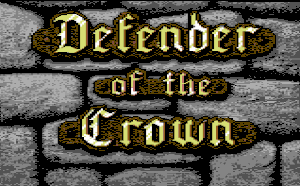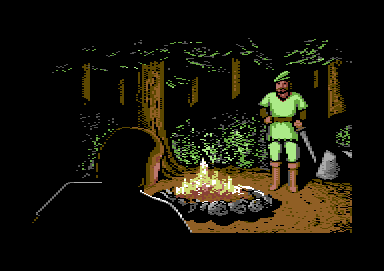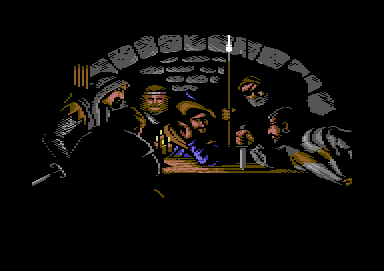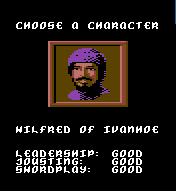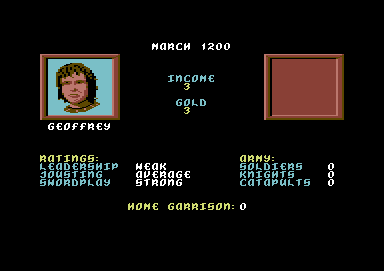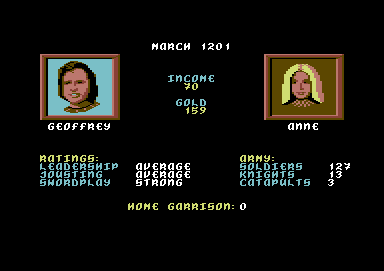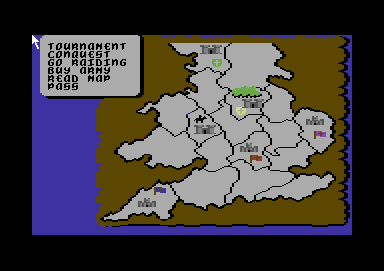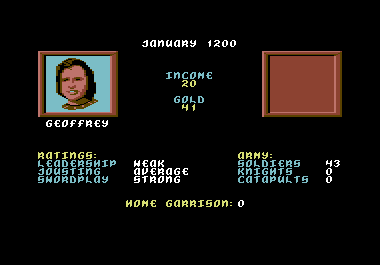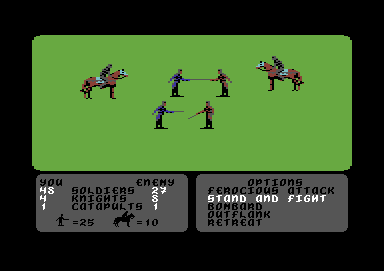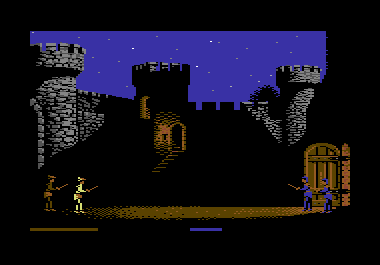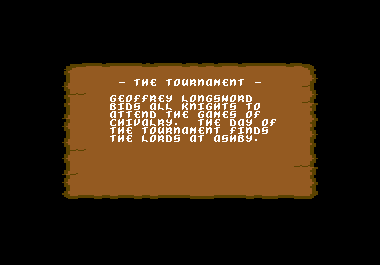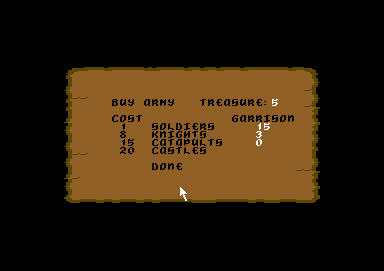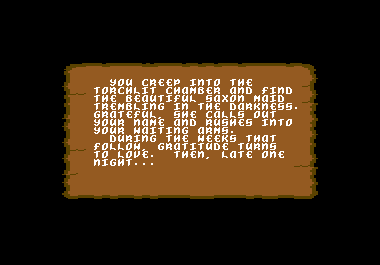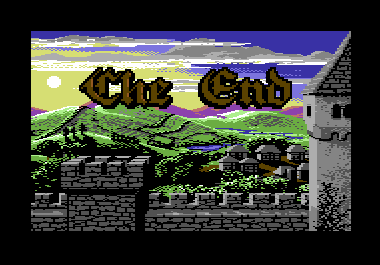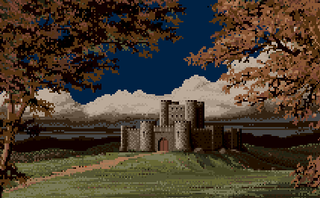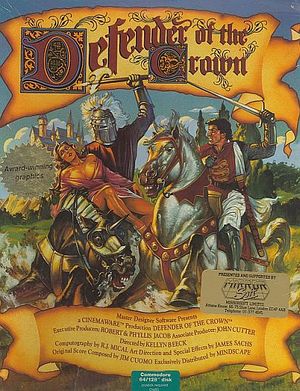Defender of the Crown
| Defender of the Crown | ||
|---|---|---|
| Game No. | 195 | |
| Voting | 8.67 points, 66 votes | |
| Developer | Kellyn Beeck | |
| Company | Cinemaware | |
| Publisher | Mirrorsoft | |
| Musician | Richard Joseph | |
| HVSC-File | MUSICIANS/J/Joseph_Richard/ Defender_of_the_Crown.sid | |
| Release | 1987 | |
| Platform | C64, Amiga, Amstrad CPC, Apple II, Apple Macintosh, Atari ST, GameBoy, iPhone, iPad, NES, PC-DOS, ZX Spectrum | |
| Genre | Strategy | |
| Gamemode | Single player | |
| Operation | ||
| Media | ||
| Language | ||
Description[edit | edit source]
Cinemaware's debut on the C64 presents itself as a strategy game peppered with action interludes around the civil war in Middle-Age England.
It is 1199: The country is divided and reigned by Anglo-Saxon as well as Norman lords. After the murder of the king and the disappearance of the king's crown the situation escalates and both parties equip for an armed conflict about the domination on the island.
As a source of inspiration served the old Hollywood knight films of the 50s, especially "Ivanhoe" as well as numerous films of the Robin Hood theme. Yonder legendary "Robin of Locksley" also briefs the player at the start of the game about the story and assists you during the campaign.
In Defender of the Crown the player takes over the role of one of the three Anglo-Saxon lords (the other two are played by the computer) and has to enlarge his at the beginning rather modest realm to get to enough money and military strength. His opponents are three Norman lords who plan exactly the same. The victor is the side, that makes it to eliminate the other by conquering their home castles.
Design[edit | edit source]
It was promised to be an "interactive movie" and this promise was kept. The game starts with a decent opening, in which programmers, graphics designer and other participants befitting their rank as well as the characters of the game are named, followed by text placards of the story, emphasized with changing music and all kinds of decorative padding.
The graphics in the game was staggeringly good for 1987, if you claim anything else, you weren't there when the jaws of the whole C64 community hit the ground collectively. Magnificently detailled outdoor views of castles, palaces and tournament places string together. The sword fights inside the castle are brilliant due to the design of the shadows in the background and the hearty smooch scene leaves nothing to be desired. A bit sparse, although completely functional, are the map and the slaughtering scenes.
The game does work without cryptic or mistakable icons, pure text in the menus make for clarity and clearness.
Slightly disappointing is on the other hand the music, which is unfortunately only in two voices and tries a bit nasal-squawkingly to imitate the sounds of the Hollywood example. But the authenticity of middle-age sound was not seeked anyway. However, the third voice, which e.g. has been "wasted" on superfluous crunching sounds during the sword fight, could have made for more depth.
It is also very convenient, that you do not need a single key and the game is completely controlled by joystick.
Hints[edit | edit source]
Choosing the character[edit | edit source]
You can choose from four different characters, each with a combination of strengths and weaknesses. The choice of the figure leads to a main focus in the later course of the game. So if you plan to win fame and acreage in tournaments, a character with good values in "Joust" can be recommended. If you are more up to robbing hostile gold reserves and freeing fair maidens, look for "Swordplay".
Wilfred of Ivanhoe
The sunnyboy of all the heroes. Has the same "strength" in everything and is therefore the ideal choice for beginners.
Cedric of Rotherwood
Dominiates the tournaments in which fame (= more leadership) or acreage (= more gold) can be expected.
Geoffrey Longsword
Makes it almost every time to the goal in robberies on hostile gold reserves and quasi rescues every abducted dame single-handedly. Fails completely as a general.
Wolfric the Wild
Well, he is just...hmm...wild? For the advanced player.
Course of the game[edit | edit source]
The game runs in rounds, whereby every round represents one month. You start in October 1199 in one of the three possible starting provinces and with an army of 20 soldiers. First, an overview table is shown, which informs you about the gold reserves, income and the size of the own army, as well as the garrison in the home castle of the player. To survive the upcoming battle of material against the Normans, one cannot avoid to improve oneself in all those categories, as the enemy starts with by far more profitable starting provinces and distinctly better character values as the own side. Furthermore, the computer controlled Anglo-Saxons play anything but aggressive and let the first rounds pass far too passively. There is acute need for action and this of course is left to you.
[edit | edit source]
By pressing the fire button the view changes to a map of England which is divided into 19 provinces. Additionally, there is the Sherwood Forest, where Robin Hood stays and which cannot get conquered. The home provinces of the lords are displayed with a castle, a hatchment or a flag show the owner. The own army is symbolized by a black horse symbol. If you lose your home castle, you will drop out of the war, even though you might have conquered other castles already. For the player this means of course "Game over".
At the upper left there is a menu with the six possible actions:
- Hold tournament Host a tournament.
- Conquest: Start a conquest.
- Go raiding: Invade a hostile castle to rob gold.
- Buy army: Enlarge your own army by spending gold.
- Read map: Get information about the province.
- Pass: Let your move pass unused.
Conquest[edit | edit source]
More land means more income and more military strength. Therefore you need to start immediately to occupy the free provinces. This is done by "Conquest.
If you choose this option, subitems appear:
- With Read map you can at first click on the adjacent provinces to see how much gold and also how many vassals they get you. Vassals are additional soldiers, who automatically join the army of the player who occupies the province first. As soon as a province has been occupied, it cannot give any more vassals.
- But to be able to conquer a province, you first have to transfer at least one soldier of your garrison army from the home castle into the "Campaign army". This is done with Transfer army and of course also works in the opposite direction, i.e. you can also return soldiers from the army in the field to the garrison.
- With Move army the campaign army is finally sent to an adjacant province. If it is neutral or it belongs to a foe, the move now ends and if necessary a fight takes place if a hostile army is there. If the field already belongs to you, you can continue this process until you reach either a hostile or a neutral province. If you move on a province of another Anglo-Saxon Lord, you can decide beforehand to either attack him (and to then have another lord as enemy for the rest of the game) or stay peaceful.
Fights[edit | edit source]
So if the own army gets involved in fights, your will be informed: a fighting screen is shown, in which the fighters are represented by single characters. A foot soldier stands for up the 25 soldiers, a rider for up to 10 knights.
While the fight goes on, you can give commands, that can influence the course of the fight, with the joystick:
- Ferocious Attack: The knights of both sides participate increasedly in the fighting. Gets you advantages, if you have more knights than the enemy. Without effect, if you have no knights.
- Stand and fight: The standard tactic, which minimizes the influence of knights, catapults and the abilities of the leaders. If you are inferior to the enemy in all issues, this is the one with which you do the least wrong.
- Bombard: The catapults of both sides intervene in the fight. Can be worth if you have more catapults than the enemy, without own catapults totally useless.
- Outflank: This gives you significant advantages for the player with the higher Leadership value.
- Retreat: Aborts the fight and you retreat to the nearest province. But if you are isolated or you defend a conquered castle, this means desctruction of your own army.
Generally you can say, that the player with the higher Leadership value has the better chances in a fight, even though he might be slightly short-handed. A leader with a low value ("weak" or "average") would need an immensely high material superiority, to stand up to an enemy which has a "good" or even a "strong" here.
Sieges[edit | edit source]
The only possibility to remove a leader permanently from the game is to conquer his home castle. For this you need at least a catapult to tear down the walls behind which the garrison is entrenched and by which it has significant advantages in the fight. If you do not succeed to blow a breach, even a manifold short-handed garrison can defend an attack successfully. The catapult is controlled by pulling the joystick backwards, the further, the higher the point of impact of the shot. You have six shots to work on the wall, after that the assault starts. There are three types of ammunition:
- Boulder: You can only damage the walls with heavy boulder projectiles. The first hit needs to be at the pinnacles, the further shots correspondingly lower. The more the wall is torn down, the lower will the defence bonus of the garrison be.
- Disease: Contaminated corpses can be thrown into the castle as soon as you have blown a breach. The earlier you use this type of shots, the more damage it will do to the defenders.
- Greek Fire: Reduces the number of defenders.
Robin's help[edit | edit source]
If you click onto the Sherwood Forest before an attack on a hostile province, you will get help up to three times from Robin Hood and his men, who make an attack and the defenders before a fight or a siege and make for some losses. This help cannot be requested if you are the target of an attack.
Go Raiding[edit | edit source]
With this action you raid a hostile castle in a cloak-and-dagger operation with the aim to rob all the collected gold reserves of the victim. Of course it is good custom that you take part yourself.
Corresponding to the ability of your own character in the field Swordplay you now have a certain amount of energy, shown in a small brown energy bar at the lower left of the screen, the second guard's energy bar depends on the victim's swordplay skill.
The own character can be moved with left and right, brought into defence position with up and down and by pressing the fire button you can stab the hostile guards.
Depending on whether you are successful in defeating the two guards standing between you and the treasure chamber, you can look forward to a warm windfall (IF the treasure chamber was actually filled) or brace yourself for a disgraceful starvation diet in the dungeon. The latter costs next to a ransom also a rank in the field of Leadership, same as also the premature leaving of the fighting area over the left border of the screen.
Some Norman lords are by the way also very talented in this discipline and are not afraid of paying you back.
Tournament[edit | edit source]
To host a tournament ends the own move. It costs at least five gold pieces and is only possible if there was no other tournament in the previous round. All the lords are now called upon to do three rounds with the lance against different enemies.
In every round the player has the choice whether he wants to fight about fame or acreage. In a duel with acreage as stake, every opponent first chooses the desired province of the enemy, which the victor will then get as a reward. The advantage of a fight about fame is the raising of the Leadership value, if you get champion of the tournament.
To successfully lift an opponent from the saddle, you steer your own lance to the center of the opponent's shield and press the fire button at the last moment, whereby the required exactness in this manoeuvre depends on the abilities of the participant in the field of Jousting. Tournament specialists as Cedric of Rotherwood can easily gain up to three acreages or a raising of the "Leadership" value in a tournament. Weaker lords however, risk a reducing of their Leadership, if they do not defeat at least one opponent.
The disreputable stabbing of the opposing horse gets a total fiasco: you will be taken away all your acreage, lose all your gold and of course your Leadership value will be reduced.
So you'd better not try this!!!
Buy Army[edit | edit source]
With the earned gold from the provinces or raids you can expand your own army, but this ends your move. You can buy the following:
- Soldiers:
They are the backbone and the cannon fodder of every army. Weak singly, but as a mass they overcome every inferior army very fast, depending on the Leadership value of their leader. They also work as an indispensable protective shield for the expansive knights.
Costs: 1 gold
- Knights:
The battle tested elite, which can do disastrous harm to the hostile foot soldiers when being behind a protective shield of soldiers. If this shield is missing, they run the risk of getting annihilated fast by a great number of enemies. If this begins to show, the fight needs to be aborted, or you will risk losing these very expensive fighters.
Costs: 8 gold
- Catapults:
Mandatory for a siege. They can also create big damage when used in bigger numbers in an open fight on the field, but as they are almost twice as expensive as knights it is rather improbable that one can afford such baubleries. If you can, then the game is already decided anyway.
Costs: 15 gold
- Castles:
Serve as mini castles with a garrison of 10 soldiers (computer players place 15 soldiers inside), which you can build in an especially valuable province. Most of the time it is not worth the trouble, as the attacker mostly runs over them with a bone-crushing superiority. Pure luxury, that you can allow yourself, if you want to waste your gold in the end phase of the game by every trick in the book. If a computer player starts to build castles, this is a sign of utmost danger!
Costs: 20 gold
Newly bought soldiers, knights and catapults are brought to the garrison on the own home castle and can be fetched there by the campaign army in the following moves.
Random events[edit | edit source]
During the game random events are triggered in irregular intervals, which can have good and bad effects. Some examples:
- The ever-popular tax collector gets robbed and you loose half of your gold.
- A province revolts and gets neutral again.
- Maraudering Danish or Wikings pillage the own acreage, which costs gold and soldiers.
- Norman rogues sabotage a catapult.
- The most spectacular and sometimes also decisive event is the robbery of a girl of an allied lord by the Normans. You are given the choice of whether to go out and rescue the poor thing in a daredevil rescue mission or you cowardly hole up and lose a rank at Leadership. If you accept, a Raid is played through, which means the melting of the two princedoms and armies if successful, which in many a precarious situation can save your skin, as the army of the ally now stands ready and available in its home castle. By the way, there is also a small film teaser.
Solution[edit | edit source]
- At the beginning make a fast expansion to the good provinces, if necessary through the area of allied Lords, to collect as man vassals as possible.
- With Read map find out which hostile Lords take part and remember their values for Leadership and Jousting, to avoid unpleasant surprises in battles on the field or in tournaments.
- As soon as all reachable provinces are allocated, buy soldiers and a catapult and go for the first Norman lord with Robin's help.
- At a siege, shoot the corpses into the castle straight after the first breach has been blown. You should neglect the Greek Fire and damage the wall further instead.
- During the sword fight on the stairs push the guard up to the head of the stairs while being in defence position and then retreat back down while pressing the fire button. If the enemy follows you now, he will get especially many hits and your yourself fewer.
- The game ends, as soon as you have captured all three home castles of the Norman lords. But if an ally makes it to own all of them, the player will be commanded to a far away village in the province by the newly elected king and the game ends rather inglorious for him.
- Altogether the "allies" are rather double-faced types: If they have nothing else to attack, they will even attack each other or the player. The player can still travel through their territories at will if he didn't attack them before.
- An attack on an Anglo-Saxon lord gets unavoidable, if you have conquered the third Norman castle and at least one of the other two is held by allies.
The Normans[edit | edit source]
In addition to inhabiting richer provinces, the Norman lords present a challenge statistically. Good luck:
Brian de Bois-Guilbert[edit | edit source]
Leadership: GOOD
Jousting: STRONG
Swordplay: GOOD
Philip Malvoisin[edit | edit source]
Leadership: GOOD
Jousting: GOOD
Swordplay: AVERAGE
Reginald Front-de-Boeuf[edit | edit source]
Leadership: AVERAGE
Jousting: GOOD
Swordplay: STRONG
Edmund the Grim[edit | edit source]
Leadership: STRONG
Jousting: AVERAGE
Swordplay: GOOD
Roger Falconbridge[edit | edit source]
Leadership: GOOD
Jousting: GOOD
Swordplay: GOOD
Cheats[edit | edit source]
The Nostalgia-Crack offers trainers for endless gold reserves, invincibility at tournaments and raids, unlimited time and ammunition during sieges, help from Robin Hood as often as you like, unsabotagable catapults as well as the possibility to start with best values for all abilities.
Also in the original version the player can cheat himself endless gold reserves by attacking an abandoned castle. However, the player must produce the latter himself by first taking possession of the home castle of a competitor by marriage or siege, and then losing it again by stabbing an opponent's horse in the tournament.
Voting[edit | edit source]
| Voting of the C64-Wiki users (10=the best vote): | ||
| 8.67 points at 66 votes (rank 16). You need to be logged in to cast a vote. | ||
| C64Games | 10 | 29th October 2013 - "highlight" - 26382 downs |
| Lemon64 | 9 | 29th October 2013 - 8,7 of 10 points - 299 votes |
| C64.COM | 9 | 11th July 2014 - 8,5 out of 10 points - 28720 downs |
| Ready 64 | 9 | 2nd December 2014 - 9,11 out of 10 points - 28 votes |
| Gamebase64 | 10 | A Classic! (English) |
| Kultboy.com | 8 | 29th October 2013 - 7,81 of 10 points - 78 votes |
| The Legacy | 8 | 26th December 2013 - "very good" - 37 votes |
| ZZap64 | 9 | Issue August 1987 - 94% - p.98 |
| ACE | 8 | Issue October 1988 - 807 points - p.45 |
| C&VG | 9 | Issue October 1987 - 9 of 10 points - p.27 |
| Commodore User | 9 | Issue August 1987 - 9 of 10 points - p.32 Disk issue November/December 1987 - 4 of 5 points - p.43 |
| Your Commodore | 9 | Issue November 1987 - 9 of 10 points - p.28 |
| 64er | 6 | Issue July 1989 |
Reviews[edit | edit source]
ASM 10/1987: "Defender of the Crown is now available as cassette for the C64! The fantastic strategy game has lost non of its fascination on the C64. It is of course clear that the graphics cannot be up there with the Amiga version of this game, but for the conditions of the C64 they are very good. A bit annoying are also the long loading times and the slow processing, but the C64 is only a small 8-bit machine. Defender of the Crown is an absolute must for people who like such games."
Robotron2084: "An impressive debut by Cinemaware. Graphically really an absolute fantastic hit. Game technically you have more details than the original, which of course is very welcome. However, a kind of monotonuous feeling appears after some time, not least through the fact, that the enemies are very predictable, if not to say: utterly daft. One can slightly compensate that by e.g. letting the first move pass unused, but this is no solution on the long run, as unorthodox strategy elements fail regularly. But fortunately, there is the random element, which rains on your parade every now and then. But it is a capital sin, that they did not simply build in a multiplayer mode into this promising basics. This would have been the absolute Lord's own top thing... what a pity! That way it stays a nice wannabe-strategy game with rather boring action intermezzos, which you eventually master just like that. But at least presented really nice, there is nothing to nag about. For a fast game every few months I can always recommend DOC, although you only need one half of the brain. But as everything fits together so neatly, I still give 8 out of 10 points."
mombasajoe: "What a thing at that time! Especially the background graphics were absolutely great. Good topic, nice atmosphere. However, the game got dusty in my disk box until this critics. Behind this great presentation (apart from the not so well-made design of the fights and the rather mediocre animation of the sword fights) hides in my opinion an entertaining but average army pushing game, based on the board game "Risk", with small but nice extras. I would not call the game a "graphic dazzler" - for this the game is "not bad enough". But they concealed quite a bit. 7/10. Because of the nice pictures."
TheRyk: "There will always be something to criticize. E.g. I always found it a bit incomprehensible or tiresome that you could not do anything with your troups after "Buy Army", the move was over. But if you didn't buy anything for 3 rounds, you could bet that you will get robbed. The tension came mainly from the random events in the first phase. But if you controlled 1/4 or 1/3 of the area, the rest was not really difficult, the more so as the AI plays relatively predictably. But if you think about what other strategy games there were for the C64, Defender of the Crown was very top. The graphics are great, the sound was good despite being in two voices and matched the knight-movie atmosphere. There have to be other games than Pirates! for which one gives 10 out of 10 points!"
Guybrush: "I also remember very well the dropped jaws due to the bombastic graphics for 1987. Of course one knew the game after some time so well that it was no challange any more but in what C64 games was this not the case? The tactial possibilites were very good, there were a few nice little things that enriched the game and it is still fun when you take it out occasionally. I also like the background sound very much, although they surely could have teased out even more. However, from me full 10 points for a milestone of the computer game history."
Shakermaker303: "Concerning the graphics it is a feast for the eyes, great pictures, nice menus, font types corresponding the game, etc... The "Ego-Shooter" perspective at the tournament with the lance ride was very impressive for its time. The music was also respectable, only I found it was not that easy to play. Anyway, a must-have for the C64 - full 10 points I give."
Nisang: " Great game with super graphics and many nice ideas. It took quite a while until I could operate the catapult correctly. After some time it was no challenge any more.
@Guybrush: In what C64 game this was not the case? Wizball: When the colours also shoot starting from the 7th level, it gets absolutely confusing. If I get hit or not is rather a coincidence.
Miscellaneous[edit | edit source]
Versions for C64[edit | edit source]
- Defender of the Crown +9D 101% byNostalgia (2004): "We did this one because JJ The Breaker/UCF told us ESI's crack was missing the winning Tournament picture. Infact all cracks i've seen of this game are built on ESI's version, and they are all missing this picture." (6R6 of NOS on CSDb)
The version is highly recommendable because of the following advantages:
- The FCS-Version includes a trainer which allows to increase the challenge for skilled players.
Versions on other platforms[edit | edit source]
The C64 version contains features as e.g. the battlefield, which could not be implemented on time in the Amiga version, as the game had to be released prematurely due to lack of money.
In the Happy Computer Special nö.17 the Amgia version received a "Happy Vote " of only 43 points, the two testing editors were not very excited about the gameplay:
Heinrich Lenhardt: "So-so - Much light, much shadow: Defender of the Crown has the best graphics that I have seen yet on a home computer. Furthermore, there are some good music pieces and an interesting plot. But the game itself... Alack, here it does look bad. At the beginning the mixture of strategy and action is much fun, but you easily win the game, which makes the motivation subside abruptly. Only the tournament duels are hardly managable: With a nice regularity I was lifted from the saddle by the lordships. Also, one can only play alone against the computer. But it is almost worth it to buy the game as a graphics demo. What you can see here on the screen, can easily be named computer art. No matter if you duel with a Norman castle (clink, clonk!) or you coquet with a rescued princess at the open fire (sizzle!)."
Gregor Neumann: "So-so - in some parts the programme reminds me more of an animated film than a game. Cinemaware wants to write games that appear like a movie, but they should not condemn the player as much to disability as in Defender of the Crown."
Meanwhile several version for PC and common consoles were published under the label Cinemaware. One of them, the "Defender of the Crown - Digitally Remastered Edition", is quasi a 1:1 conversion of the classic C64 version, in which only the old graphics and sounds were refined correspondingly to the better possibilites, the gameplay is almost identical. Another Cinemaware publication named "Robin Hood: Defender of the Crown" has only little in common with the C64 original, except for the story.
Cover[edit | edit source]
The cover art of Defender of the Crown was put together by Peter Green Design and painted by Ezra Tucker, a renowned illustrator who has worked for Walt Disney and Universal Studios. He has won several awards and his work can be found in museum exhibitions and Fortune 500 collections.
Randy McDonald was in charge of art direction, design, and production for Cinemaware's first four games, and he explains in an interview that "Peter Greene or I would do a sketch of generally what we wanted for each cover. I went to Western Costume in Hollywood, which for many decades was the giant in the costume industry there, and rented costumes for the types of ”look” we had settled on for each cover. We hired models and brought them into Peter’s large photo studio, where we set them up in the costumes I had rented, posed as closely as possible to the way we wanted them to be illustrated."
The supposed artist, according to Randy McDonald, was supposed to be a Greg Winter - but eventually Ezra Tucker ended up being the final artist for the cover art.
Highscore[edit | edit source]
- Unfortunately there is no final evaluation.
Links[edit | edit source]
| Wikipedia: Defender_of_the_Crown |
- C64Games.de - Game No. 534
- Lemon64 - Game No. 661
- Gamebase64.com - Game No. 2082
- C64.com - Game No. 118
- CSDb - Release No. 19181 recommended version "Defender of the Crown +9D 101%" by NOS
- Test Report No. 291 on Kultboy.com

- TheLegacy entry no.4108
- Test Report No. 291 on Kultboy.com

- Cult figures from the game on Kultboy.com (Comparison Amiga/C64)
- How the cover art of Defender of the Crown was made on Spelpappan.se
- ZZap64 test report
- The SixtyFour Originals DataBase - Game No. 420
- CSDb
Videos
- Video at YouTube A longplay by xwonderer with the ccs64 emulator
- Video at YouTube DerSchmu grabs the Crown in highspeed mode
Remark[edit | edit source]
The German version of this article on "www.C64-Wiki.de" was "article of the month" in August 2008 and "article of the year" 2008.
